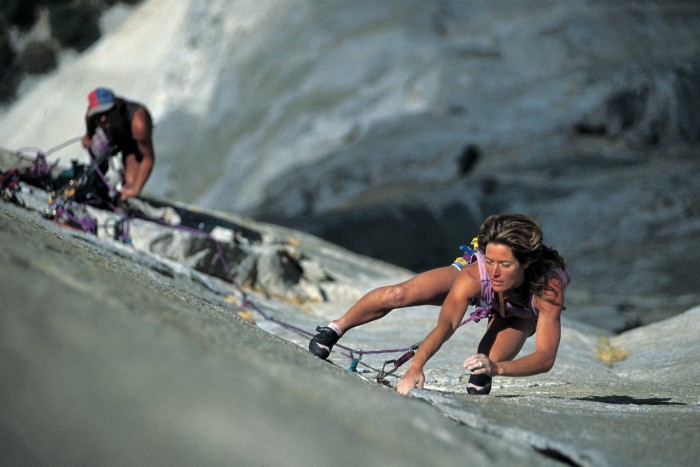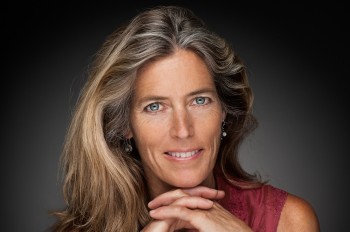Ladies we Love: 5 Questions with Lynn Hill

Lynn Hill is a monumental icon in the climbing world—and not just in the women’s climbing arena. In 1994, Hill changed the perception of what was humanly possible: She became the first person to complete a single-day free ascent of The Nose, a 2,900-foot route on El Capitan in Yosemite Valley, CA. The feat wasn’t matched until a decade later when Tommy Caldwell free climbed both the Nose and Freerider—double the distance—in a single 23-hour sweep.
Now, across her 39-year climbing career, Hill has continuously rocked record-breaking ascents.
Hill was the first female to climb a 5.12d rated route in 1979. Twelve years later she became the first woman to bag a 5.14 route, three years before any other woman.
In 1999, she led an all-ladies first ascent up a 2,000-foot granite wall in Madagascar—considered to be the most difficult big wall first ascent to be completed by a female team in history.
She’s finessed her skills in everything from bouldering and crag to big wall alpine climbing in locations all over the world, including France, Italy, Vietnam, Thailand, China, Australia, and Morocco. Here, we catch up with this professional climber and mother to see what she’s learned from her life-long climbing journey—and, what’s in store ahead.
WomensMovement: What are the biggest lessons that you’ve learned through climbing?
Lynn Hill: Humility. What I mean by that is facing my own ego and who I am. The lessons you learn through climbing make you look at who you are and how you’re doing and how you face the world. It’s a unique physical expression, and even if you do the same climb you can never do it the same way twice. It’s a state of mind, a moving meditation. It’s allowed me to broaden my perspective on humanity and the human experience through travel.
When I competed on the international climbing competition circuit, I felt a lot of pressure to win because I knew that I could. But, when all eyes were focused on me during critical moments of difficulty, sometimes I made mistakes. If I was nervous or overly concerned about the outcome, I wasn’t able to climb in a natural way. Through my experiences in competition, I learned to accept my feelings of insecurity to be present without judgement.
WM: In reflecting on all of your climbing accomplishments, what is the most memorable for you?
Hill: Free climbing the Nose in one day in 1994, when I was the first person—man or woman—to make an all free ascent of the Nose in a day. It was a historic climb. It was important because there weren’t very many women who had done any significant first ascents on the big walls of Yosemite—Beverly Johnson had done some amazing assents—and climbing was early enough in its evolution. I thought, why couldn’t I just lead the way and do something that hadn’t been done? It was important enough to me to try my best to raise the bar and challenge the old beliefs ways of thinking about what’s possible for a woman.
In 1993, I first did [the Nose] in four days—it was the first free ascent of the Nose for any man or woman. The advantage is that if you’re tired you can go to a ledge and rest as long as necessary. Eleven years later Tommy Caldwell was the first person to climb the Nose and Freerider in one day. Being in a male-dominated sport that combines the psychological attitude with grace, fluidity, and strength—kind of like gymnastics—it’s a testimonial that women are capable of amazing feats.
WM: Having climbed all over the world, how does climbing culture compare across countries?
Hill: Climbers from all over the world enjoy climbing in certain iconic locations, such as the Alps in Europe. This magnificent mountain range has attracted people for hundreds of years and has a rich climbing history. Climbers tend to enjoy being challenged and fully engaged in the act of climbing and generally appreciate the beauty of nature and following a relatively simple way of life. Climbing in America is much more developed noe than it was when I started 39 years ago.
When I first began to climb I had never even seen a picture of a climber. Now there are so many young kids climbing at an incredibly high level after climbing for only a few years at their local rock gym!
Climbing is still a relatively small sport. It hasn’t even made it to the Olympics. It’s hard to have a consensus worldwide on how to structure climbing competitions since there are so many different types of climbing from speed climbing and bouldering to ice climbing or free climbing on artificial walls.
WM: What are your climbing-related goals?
Hill: I would like to climb a 5.14. It would require that I optimize more than I ever have because I am older and I have less time; I’m a single mom and I have a son to take care of. I’d like to be efficient and do that, but, it’s not a fixed goal—I also just like to climb. I enjoy being outside and being with friends, and my favorite range of climbing is a 5.11 to 5.12d. I like to be pushed and figure things out and I enjoy the process of working out the most efficient way to connect the moves. It feels good to move up the rock.
WM: Do you climb with your son?
Hill: He does like to climb, but he’s more interested in doing his own activities such as Parkour. He hasn’t chosen climbing because it’s my thing. It’s my lifestyle and how I make a living, and I think that’s intimidating. I think it works out better if it’s just the occasional recreational activity for him.

Kamagra oral jelly Online something to buy the most convenient way. He doesn’t demand from you any actions except how to visit the website. And in separate with goods necessary to you to put the end. To specify your address and to wait for the supplier to whom you will give money.


LET'S GET SOCIAL